Gemstones 101: Alexandrite, the Color-Changing Stone
Welcome to Gemstones 101, a series at Takayas Custom Jewelry where we shed a little light on the amazing gemstones we love to feature in our jewelry projects. This week's entry focuses on a magnificent jewel with an incredible talent that's taken the world by storm - the color-changing alexandrite!
Alexandrite is a variant of chrysoberyl, a mineral consisting of an oxide of beryllium and aluminum (and, humorously, of no relation whatsoever to the mineral beryl). First stumbled upon in the Ural Mountains of Russia in the 1830s, legend has it that this stunning gem was named after the future Tsar Alexander II, who came of age around the time of the gem's discovery. With a reputation steeped in royal symbolism and heightened by its exclusivity, it's no surprise that the noble alexandrite has easily found its place among the most desirable of gemstones!

Small amounts of chromium ions in alexandrite's crystal structure produce the rich shades we associate with this beautiful stone. Not just of one color, but two! Under different lighting, these ions allow alexandrite to take on a startling array of colors, a phenomenon referred to as the "alexandrite effect". Intense absorption of light over a narrow range of wavelengths create a stone that's typically bluish-green in full daylight, and transformed to a deep violet or raspberry red in incandescent light - earning alexandrite its renown as an "emerald by day, ruby by night."
Despite alexandrite's massive popularity, prospective buyers should know that the stone is actually exceedingly rare in nature. Found in very few places on earth, natural alexandrite demands a steep price - even stones smaller than 1-carat can be more expensive than diamonds. If you're a die-hard fan of the alexandrite effect, however, never fear! Synthetic alexandrite is out there, created by specialized techniques that grow stones just as brilliant as a natural gem. Just be careful you don't get synthetic alexandrite confused with simulated alexandrite, which is usually lab-grown corundum (i.e. rubies and sapphires) laced with vanadium to produce the color change.

For jewelry lovers who are looking for something that exceeds the ordinary, alexandrite would make a fantastic centerpiece for your next special project. Make a bold statement with a ring crested by this regal stone, or flaunt a one-of-a-kind a pair of color-changing earrings - it's up to you! Whichever way you choose to show off your alexandrite, we can assure you that you'll be utterly enchanted by its magic.
Are you ready to begin your custom journey? Visit our Options page to begin crafting, or visit our Inquire page to get in touch with Takayas.

